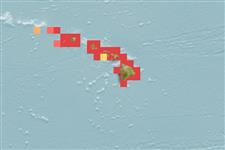>
Mulliformes (Goatfishes) >
Mullidae (Goatfishes)
Etymology: Parupeneus: Latin, parum, parvum = small + Peneus, the name of a river.
Issue
FishBase common name coined in Uiblein et al. (2024: Ref. 130857). Whitesaddle goatfish was previously used for Parupeneus ciliatus.
Environment: milieu / climate zone / गहराई सीमा / distribution range
पारिस्थितिकी
समुद्री प्रवाल-भित्ति संयुक्त; गहराई सीमा 1 - 140 m (Ref. 9710). Tropical; 24°N - 18°N, 164°W - 153°W
Eastern Central Pacific: Hawaii.
Length at first maturity / आकार / वज़न / Age
परिपक्व अवधि: Lm ?, range 26 - ? cm
Max length : 51.0 cm TL पुल्लिंग / अलिंग; (Ref. 54393)
पृष्ठीय रीढ़ (सम्पूर्ण) : 8; पृष्ठीय सौफट रेज़ (सम्पूर्ण) : 9; ऐनल सौफट रेज़: 7; जानवरों की रीड़ का जोड़: 24. Diagnosis: Pectoral rays 15 (rarely 14 or 16). Gill rakers 6-7 + 24-27 (total 30-34). Body depth 2.85-3.25 in SL; head length (HL) 2.85-3.1 in SL; snout length 1.85-2.2 in HL; barbels short, 1.65-1.95 in HL; longest dorsal spine 1.55-1.85 in HL; last dorsal ray slightly longer than penultimate ray; posterior margin of each caudal lobe convex; pectoral-fin length 1.3-1.5 in HL; pelvic-fin length 1.2-1.4 in HL. Body red to reddish brown dorsally, light red ventrally, with a white saddle-like spot on caudal peduncle flanked anteriorly and posteriorly by a dusky spot, the posterior one darkest; a reddish brown band from front of snout through eye and along body to above lateral line, fading and broadening below second dorsal fin, dark band behind eye and anteriorly on body bordered by a white band; fins mainly red; barbels white (Ref. 54393).
Body shape (shape guide): fusiform / normal.
Inhabits lagoon and seaward reefs; in small groups under ledges or among corals by day, dispersing at night to feed among rocks and corals on benthic crustaceans (Ref. 9710). It is a nocturnal predator that feeds mostly on benthic crustaceans (Ref. 13550). Spawning appears to be year-round with the peak from December to July; females may spawn more than once a year (Ref. 54393).
Life cycle and mating behavior
परिपक्व अवधि | पुनरुत्पत्ति | मछलीऔ का अंडे देना | अंडे | Fecundity | लार्वा
Randall, J.E., 2004. Revision of the goatfish genus Parupeneus (Perciformes: Mullidae), with descriptions of two new species. Indo-Pac. Fish. (36):64 p. (Ref. 54393)
IUCN Red List Status (Ref. 130435: Version 2025-1)
Threat to humans
Harmless
Human uses
मात्स्यिकी: व्यापारिक
साधन
Special reports
Download XML
इंटरनेट स्रोत
Estimates based on models
Preferred temperature (संदर्भ
123201): 8.9 - 25.5, mean 20.3 °C (based on 8 cells).
Phylogenetic diversity index (संदर्भ
82804): PD
50 = 0.5000 [Uniqueness, from 0.5 = low to 2.0 = high].
Bayesian length-weight: a=0.02239 (0.01117 - 0.04486), b=3.19 (3.02 - 3.36), in cm total length, based on LWR estimates for this species & Genus-body shape (Ref.
93245).
Trophic level (संदर्भ
69278): 4.0 ±0.60 se; based on food items.
Generation time: 2.0 ( na - na) years. Estimated as median ln(3)/K based on 1
growth studies.
लौटाव (संदर्भ
120179): माध्यम, न्यूनतम जनसंख्या दुगनी होने का समय 1.4 - 4.4 वर्ष। (K=0.5; tm=1).
Fishing Vulnerability (Ref.
59153): Low to moderate vulnerability (27 of 100).
🛈
Nutrients (Ref.
124155): Calcium = 27.7 [13.3, 62.8] mg/100g; Iron = 0.303 [0.148, 0.682] mg/100g; Protein = 18.2 [14.9, 21.2] %; Omega3 = 0.139 [0.076, 0.264] g/100g; Selenium = 71.5 [33.1, 172.0] μg/100g; VitaminA = 137 [27, 604] μg/100g; Zinc = 0.409 [0.241, 0.803] mg/100g (wet weight);
